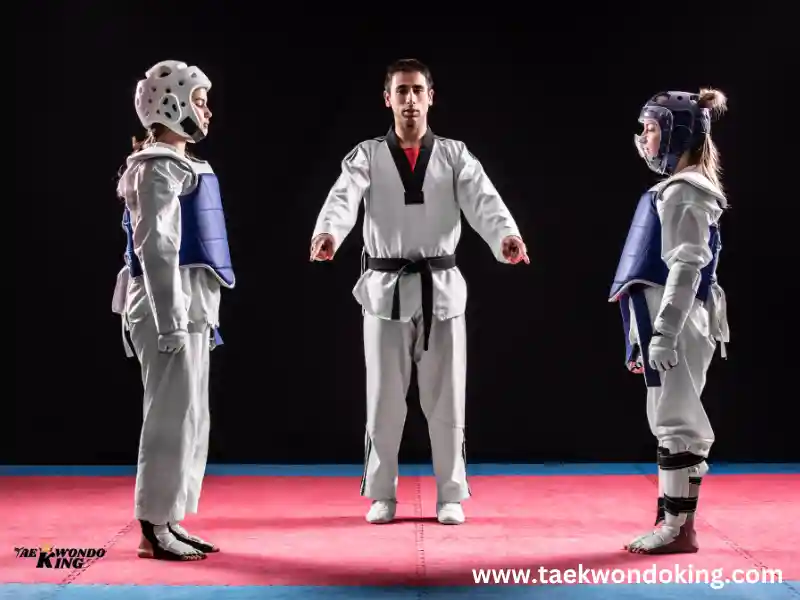
I first stepped onto the Taekwondo mat, I felt like I was speaking a foreign language, usable words in Taekwondo seemed like a secret code! Over time, I realized that these terms weren’t just jargon; they were keys to unlocking the true essence of the art. Having trained for years, I’ve learned how these words connect every move, helping you understand the depth behind the punches and kicks. Let me guide you through the most important usable words in Taekwondo and why they’ll make all the difference in your training. Ready to talk the talk and walk the walk? Let’s jump in!
Get updates by joining Taekwondoking official WhatsApp channel.
learning Taekwondo, it’s important to familiarize yourself with common and most useful words in Taekwondo and the practice. Some common words in Taekwondo include Dojang (training hall), Dobok (uniform), Taekwondo (the name of the martial art), Kyorugi (sparring), Poomsae (forms), and Kihap (yell). Understanding these words will help you communicate effectively and better immerse yourself in the practice of Taekwondo.
Taekwondo, like any martial art, has its specific terminology and language. Here are some common and most usable words and phrases that every Taekwondo practitioner should know and understand.

10 Common and most useful words in Taekwondo with meaning
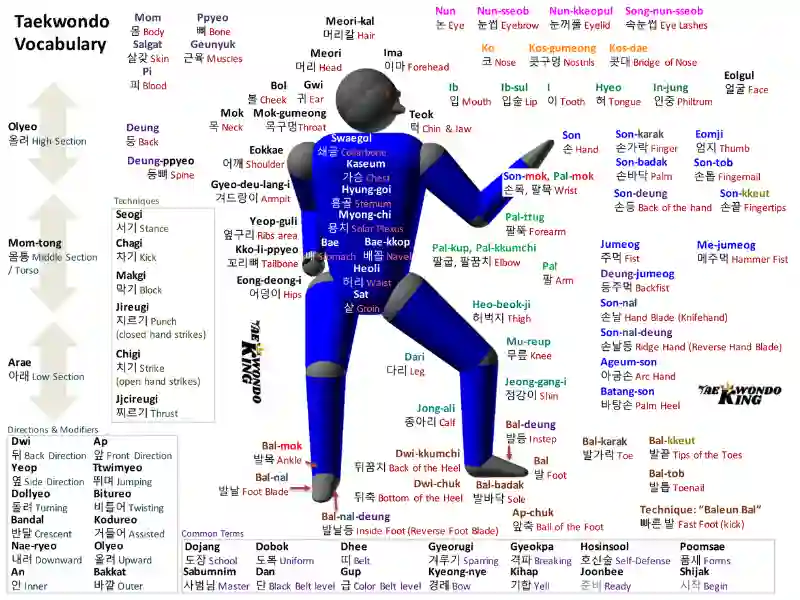
1. Dobok (도복): Meaning: The traditional Taekwondo uniform worn by practitioners, symbolizing respect and unity.
2. Dojang (도장): Meaning: The training hall or studio where Taekwondo is practiced, fostering discipline and focus.
3. Poomsae (품새): Meaning: A set sequence of movements, forming the basis of Taekwondo forms and emphasizing technique and fluidity.
4. Kihap (기합): Meaning: The sharp, controlled shout emitted during movements, channeling energy and focus.
5. Kyorugi (교루기): Meaning: Sparring or competitive fighting, is a crucial aspect for applying techniques in a dynamic setting.
6. Kup (급): Meaning: The colored belt ranks in Taekwondo, signifying a practitioner’s level of expertise.
7. Kwanjang (관장): Meaning: The head instructor or master of a Taekwondo school, guiding students on their martial arts journey.
8. Tangsoodo (당소도): Meaning: A Korean martial art that shares roots with Taekwondo, emphasizing both hand and foot techniques.
9. Hwarang (화랑): Meaning: A historical group of elite youth in ancient Korea, embodying the virtues of loyalty, courage, and integrity.
10. Kamsahamnida (감사합니다): Meaning: “Thank you” in Korean, reflecting the spirit of gratitude and respect within the Taekwondo community.
Understanding these common and usable words in Taekwondo not only enhances your vocabulary but also deepens your connection to the art’s cultural and philosophical foundations. Embrace the journey of continuous learning and growth as you explore the meanings behind these integral terms in the world of Taekwondo.

How to pronounce Taekwondo words?
Pronouncing Taekwondo words correctly involves understanding the phonetics of the Korean language. Here I am given a general guide on how to pronounce some common Taekwondo terms:
Taekwondo (태권도):
- Pronunciation: Tae-kwon-do
- Note: “Tae” sounds like “Tay,” “Kwon” sounds like “kwan,” and “do” sounds like “dough.”
Dojang (도장):
- Pronunciation: Doh-jahng
- Note: The “do” in “Dojang” is pronounced like “dough,” and “Jang” rhymes with “bang.”
Dobok (도복):
- Pronunciation: Doh-bok
- Note: The “do” in “Dobok” is pronounced like “dough,” and “bok” sounds like “bawk.”
Poomsae (품새):
- Pronunciation: Poom-say
- Note: “Poom” rhymes with “room,” and “sae” sounds like “say.”
Charyeot (차렷):
- Pronunciation: Cha-ryut
- Note: “Cha” sounds like “cha” in “charity,” and “ryut” rhymes with “foot.”
Kihap (기합):
- Pronunciation: Kee-hap
- Note: “Kee” rhymes with “key,” and “hap” rhymes with “cap.”
Kyungnae (경내):
- Pronunciation: Kyung-nay
- Note: “Kyung” rhymes with “young,” and “nae” sounds like “nay.”
Gyeorugi (교루기):
- Pronunciation: Gyo-roo-gi
- Note: “Gyo” rhymes with “yo,” “roo” sounds like “roo” in “kangaroo,” and “gi” rhymes with “key.”
Keep in mind that pronunciation may vary slightly based on regional accents and individual preferences. If possible, seek guidance from a Taekwondo instructor or a native Korean speaker for precise pronunciation.
Common and most useable words in Taekwondo for beginners
Arming yourself with these basic Taekwondo words equips beginners not only with the language of the art but also with a deeper connection to its cultural and philosophical roots. Embrace the learning process, and soon these words will become second nature in your Taekwondo journey. Here are the lists of Common and most useful words in taekwondo for beginners:
1. Dobok (도복)
2. Dojang (도장)
3. Kihap (기합)
4. Poomsae (품새)
5. Kyorugi (교루기)
6. Kup (급)
7. Taekwondo Kicks:
- Ap Chagi (앞 차기)
- Dollyo Chagi (돌려 차기)
- Yop Chagi (옆 차기)
8. Sonkal (손칼)
9. Hoshinsool (호신술)
10. Kamsahamnida (감사합니다)
Tips for Practicing Commands:
- Consistency is Key: Practice these commands regularly to ensure immediate and precise responses.
- Understanding Korean Pronunciation: Familiarize yourself with the correct pronunciation to enhance the fluidity of your training.
Embracing these 5 basic commands in Taekwondo not only cultivates a disciplined training environment but also instills the core values of respect and humility. As practitioners progress, these commands become second nature, embodying the essence of Taekwondo’s rich tradition and philosophy.
05 Basic Commands in Taekwondo
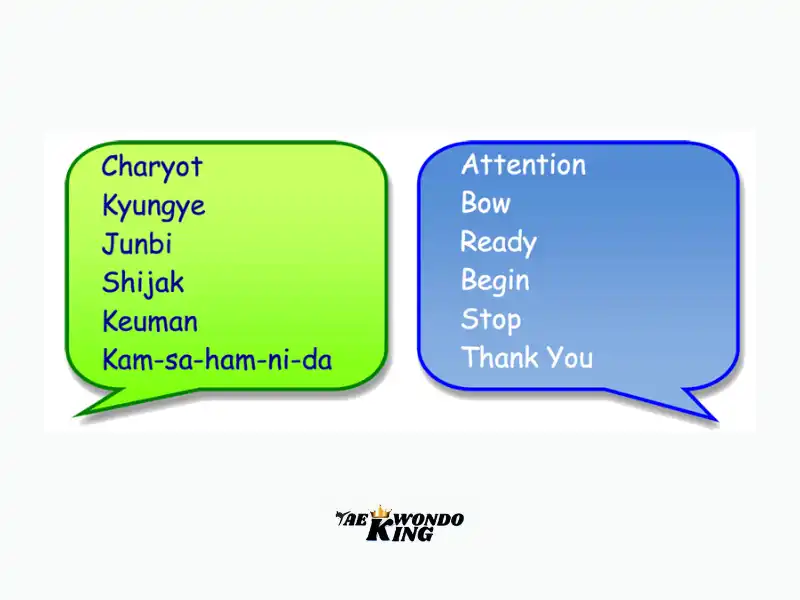
Taekwondo, a martial art that emphasizes discipline and respect, incorporates essential commands that form the cornerstone of training. For both beginners and seasoned practitioners, understanding and executing these basic commands is crucial. Let’s delve into the fundamental 5 commands that lay the groundwork for every Taekwondo journey:
1. Charyeot (차렷): Meaning: “Attention”
- Importance: This command signals practitioners to stand at attention, fostering focus and readiness for instruction.
2. Gyeongnye (경례): Meaning: “Bow”
- Importance: A gesture of respect, the bow is central to Taekwondo etiquette, symbolizing humility and mutual respect.
3. Baro (바로): Meaning: “Return” or “Come back”
- Importance: Used during forms or drills, “Baro” instructs practitioners to return to the starting position after completing a movement.
4. Kyungnae (경내): Meaning: “Respect”
- Importance: Reinforcing the core tenet of respect in Taekwondo, this command is often given before and after partner drills or sparring.
5. Sheeuh (시원): Meaning: “At ease” or “Relax”
- Importance: Following rigorous training or when the instructor wants to convey a more relaxed atmosphere, “Sheeuh” allows practitioners to ease tension.
Taekwondo Numbers – English to Korean at 01-20
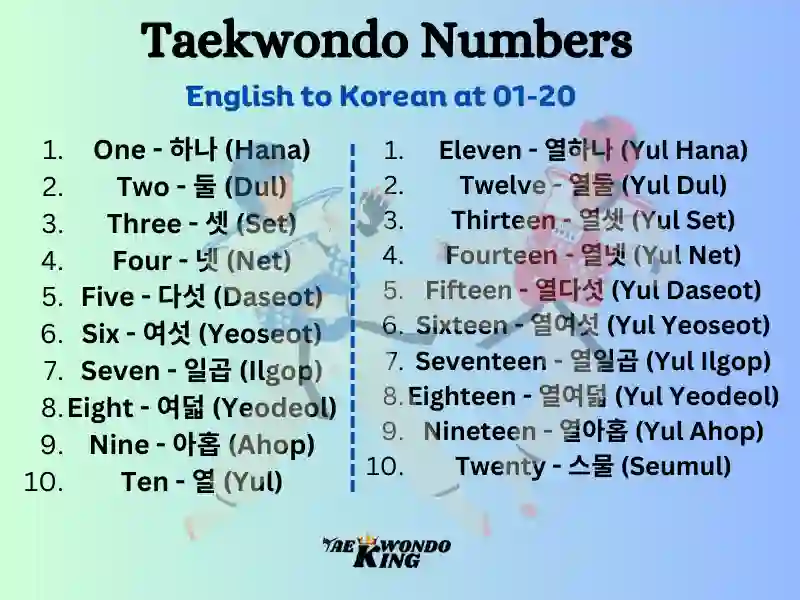
Here are the numbers from 1 to 20 in English and their corresponding translations in Korean for Taekwondo:
- One – 하나 (Hana)
- Two – 둘 (Dul)
- Three – 셋 (Set)
- Four – 넷 (Net)
- Five – 다섯 (Daseot)
- Six – 여섯 (Yeoseot)
- Seven – 일곱 (Ilgop)
- Eight – 여덟 (Yeodeol)
- Nine – 아홉 (Ahop)
- Ten – 열 (Yul)
- Eleven – 열하나 (Yul Hana)
- Twelve – 열둘 (Yul Dul)
- Thirteen – 열셋 (Yul Set)
- Fourteen – 열넷 (Yul Net)
- Fifteen – 열다섯 (Yul Daseot)
- Sixteen – 열여섯 (Yul Yeoseot)
- Seventeen – 열일곱 (Yul Ilgop)
- Eighteen – 열여덟 (Yul Yeodeol)
- Nineteen – 열아홉 (Yul Ahop)
- Twenty – 스물 (Seumul)
These translations can be helpful for practitioners learning Taekwondo commands or participating in drills where counting plays a significant role.
Taekwondo names for Common body parts – English to Korean

Here are the names of various body parts in English and their corresponding translations in Korean for Taekwondo:
- Head – 머리 (Meori)
- Eyes – 눈 (Nun)
- Nose – 코 (Ko)
- Mouth – 입 (Ip)
- Neck – 목 (Mok)
- Shoulders – 어깨 (Eokkae)
- Chest – 가슴 (Gaseum)
- Back – 등 (Deung)
- Stomach – 배 (Bae)
- Arm – 팔 (Pal)
- Elbow – 팔꿈치 (Palkkumchi)
- Forearm – 전완 (Jeonwan)
- Wrist – 손목 (Sonmok)
- Hand – 손 (Son)
- Fingers – 손가락 (Sonkarak)
- Leg – 다리 (Dari)
- Thigh – 허벅지 (Heobeokji)
- Knee – 무릎 (Mureup)
- Shin – 정강이 (Jeonggangi)
- Foot – 발 (Bal)
- Toes – 발가락 (Balgarak)
These translations can be useful for Taekwondo practitioners to understand and communicate about specific body parts during training or instruction.
Taekwondo kicks Name the most useable words
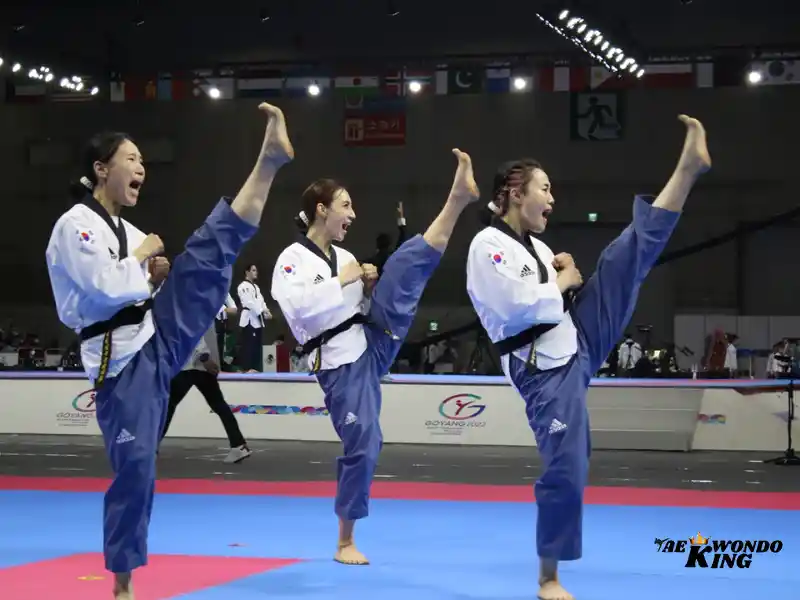
In Taekwondo, there are various kicks name that practitioners learn as part of their training. Here are the names of some common Taekwondo kicks:
- Front Kick – Ap Chagi (앞 차기): A straightforward kick delivered with the ball of the foot.
- Roundhouse Kick – Dollyo Chagi (돌려 차기): A circular kick typically targeting the opponent’s midsection with the top of the foot.
- Side Kick – Yop Chagi (옆 차기): A lateral kick directed towards the side of the opponent.
- Back Kick – Dwi Chagi (뒷 차기): A kick executed backward, striking with the heel.
- Hook Kick – Huryeo Chagi (후려 차기): A kick performed in a hooking motion, targeting the opponent from an angle.
- Crescent Kick – Bandal Chagi (반달 차기): A sweeping kick in a circular motion, usually targeting the head or neck.
- Axe Kick – Naeryeo Chagi (내려 차기): A downward kick, often used against an opponent on the ground.
- Push Kick – Mireo Chagi (밀려 차기): A pushing motion kick, creating distance between the practitioner and the opponent.
- Spinning Hook Kick – Dwibal Huryeo Chagi (뒷 발 후려 차기): A spinning motion followed by a hook kick.
- Jumping Front Kick – Twimyo Ap Chagi (뛰어 올라 앞 차기): A front kick executed while jumping, adding height and power to the kick.
- Jumping Roundhouse Kick – Twimyo Dollyo Chagi (뛰어 올라 돌려 차기): A roundhouse kick performed with a jump, combining agility and precision.
- Jumping Side Kick – Twimyo Yop Chagi (뛰어 올라 옆 차기): A side kick executed with a jump, targeting the opponent’s side.
These are just a few examples of the diverse kicks in Taekwondo. Practitioners often train extensively to master the techniques and use them effectively in various situations.
What are the 15 terms related to Taekwondo?
Are you new to Taekwondo or looking to brush up on your terminology? This guide covers the essential terms every practitioner should know to better understand the Common and Most useable words in Taekwondo. Whether you’re a beginner or an experienced practitioner, knowing these common words and phrases will enhance your experience in Taekwondo. Here are 15 terms related to Taekwondo:
- Dojang (도장): The training hall or studio where Taekwondo is practiced.
- Dobok (도복): The official Taekwondo uniform worn by practitioners.
- Poomsae (품새): A set sequence of movements or forms, emphasizing technique and discipline.
- Kihap (기합): The sharp, controlled shout emitted during movements, aiding in concentration.
- Kyungnae (경내): The command for mutual respect or bowing, often used before and after drills or sparring.
- Gyeorugi (교루기): Sparring or controlled fighting, allowing practitioners to apply techniques in a dynamic setting.
- Kup (급): The colored belt ranks, signifying a practitioner’s level of expertise.
- Hosinsul (호신술): Self-defense techniques, empowering practitioners to protect themselves.
- Kwanjang (관장): The head instructor or master of a Taekwondo school.
- Hwa Rang (화랑): A historical group of elite youth in ancient Korea, embodying virtues like loyalty and courage.
- Charyeot (차렷): The command for “Attention,” signaling practitioners to stand at attention.
- Gyeongnye (경례): The command for “Bow,” symbolizing respect and humility.
- Baro (바로): The command for “Return” or “Come back,” is often used during forms or drills.
- Sonkal (손칼): The knife-hand strike, a versatile hand technique for striking or blocking.
- Taekwon (태권): The combination of “Tae” meaning foot or kick, “Kwon” meaning fist or hand, and “Do” meaning way or path, representing the art of kicking and punching.
These terms encompass various aspects of Taekwondo, from basic commands to advanced techniques and cultural elements.
What do you say when doing Taekwondo?
In Taekwondo, there are specific commands and expressions used during training to ensure discipline, respect, and effective communication. Here are some common phrases and commands you might hear or use in Taekwondo:
- Charyeot (차렷): This command means “Attention.” Practitioners stand at attention, ready to receive instructions.
- Kukgi Baegi (국기 배기): This phrase is used during the raising or lowering of the national flag (Kukkiwon flag).
- Gyeongnye (경례): This command is given for “Bow,” a gesture of respect and humility.
- Baro (바로): When given this command, practitioners return to the starting position.
- Shijak (시작): Meaning “Begin” or “Start,” this command initiates an activity or a drill.
- Kihap (기합): The shout emitted during movements, enhancing focus and energy.
- Guman (그만): Used to stop or halt an activity, meaning “Stop” or “Enough.”
- Kallyeo (깔려): This command is used during sparring, instructing practitioners to take a fighting stance.
- Anjo (앉아): Meaning “Sit,” this command is given when practitioners are required to sit down.
- Swiyo (쉬어): This command means “Rest” or “Take a break,” allowing practitioners to relax momentarily.
- Gyukpa (격포): This command is used to break boards during demonstrations or testing.
- Kamsahamnida (감사합니다): To express gratitude or say “Thank you.”
These commands contribute to the structure and discipline of Taekwondo training, creating a focused and respectful environment within the dojang (training hall).

FAQ
What are Taekwondo terms?
Taekwondo terms refer to a set of specific words and commands used within the practice of this Korean martial art. These terms encompass various aspects of Taekwondo training, including commands for movement, respectful gestures like bows, specific techniques such as kicks and strikes, and the ranks denoted by colored belts. Understanding Taekwondo terms is essential for effective communication between practitioners, instructors, and the cohesive functioning of a dojang (training hall). Mastering these terms not only facilitates the precise execution of techniques but also reflects a practitioner’s dedication to the discipline, respect for tradition, and adherence to the philosophical principles embedded in Taekwondo.
How do you say thank you in Taekwondo?
In Taekwondo, to express gratitude or say “thank you,” you can use the Korean word “Kamsahamnida” (감사합니다). This term is commonly used in various contexts, including within the dojang (training hall), to show appreciation and respect. So, whether you’re acknowledging your instructor, training partners, or anyone else, saying “Kamsahamnida” is a polite way to convey thanks in the practice of Taekwondo.
What is the word for the start in Taekwondo?
In Taekwondo, the word for “start” is “Shijak” (시작). This command is used to initiate an activity, a drill, or any sequence of movements during training. When “Shijak” is given, practitioners begin the designated exercise, emphasizing the importance of timing, precision, and readiness in Taekwondo practice.
How do you say hello in Taekwondo?
In Taekwondo, to greet someone or say “hello,” you can use the word “Annyeonghaseyo” (안녕하세요). This is a common and polite greeting in Korean, and it is suitable for use within the Taekwondo community as well. It is a versatile greeting used in various contexts, including the dojang (training hall).
How do you say relax in Taekwondo?
In Taekwondo, to say “relax,” you can use the Korean word “Sheeuh” (쉬어). This command is often given by instructors during training to indicate that practitioners can take a break or momentarily relax before the next set of activities. It’s a term used to encourage a brief pause in training, allowing practitioners to rest and regather their energy.
What are the words commonly used in Taekwondo?
In Taekwondo, a martial art rich in tradition and discipline, practitioners commonly use a set of specialized words that form the foundation of effective communication within the dojang. These words encompass basic commands like “Charyeot” (Attention) and “Kyungnae” (Bow), essential movements known as “Poomsae,” and various kicks such as “Ap Chagi” (Front Kick) and “Dollyo Chagi” (Roundhouse Kick). Additionally, terms like “Dojang” (training hall) and “Dobok” (uniform) are integral to the Taekwondo lexicon. Mastery of these words not only facilitates seamless instruction and practice but also reflects a practitioner’s commitment to the art’s cultural and philosophical principles, fostering a strong sense of unity within the Taekwondo community.

Founder, Owner, and CEO of TaekwondoKing.
He is one of the top 100 martial artists in the World and among the top 20 referees in Bangladesh.
Ehatasamul Alom is an esteemed Kukkiwon Certified Taekwondo 3rd Dan Black Belt with over 15 years of experience in this dynamic martial art. Born in Rajshahi, Bangladesh, Ehatasamul’s journey with Taekwondo began at the tender age of seven. His passion led him to compete at national and international levels, where he has bagged numerous awards and honors. He is also a member of the Taekwondo National Referee Panel.
With a Bachelor’s degree in Sports Science from the prestigious Rajshahi University, Ehatasamul has a deep understanding of the technical and scientific aspects of martial arts and some other martial arts.
In 2022, Ehatasamul created the “TaekwondoKing.com” to share his knowledge, Free Resources, Values, and Real experiences. His articles focus on Taekwondo training techniques, competition strategies, Sport Products Reviews, and the art’s rich history and philosophy. He also writes about the importance of mental fortitude and discipline, key aspects of his teaching philosophy. He has already launched many sports, Taekwondo, and health-related Free online tools. His goal is to inspire both beginners and seasoned practitioners worldwide through insightful and engaging content.
If you need any help, contact Ehatasamul Alom at any time.


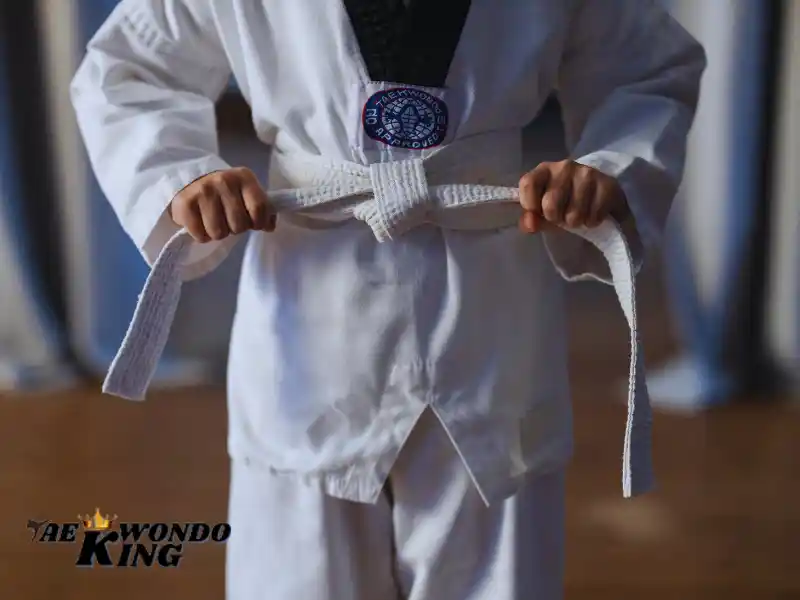


I love what you guys tend to be up too. This kind of clever work and reporting!
Keep up the awesome works guys I’ve incorporated you guys to blogroll.
I was suggested this website by my cousin. I am not sure whether this post is written by
him as nobody else knows such details about my difficulty.
You are amazing! Thanks!